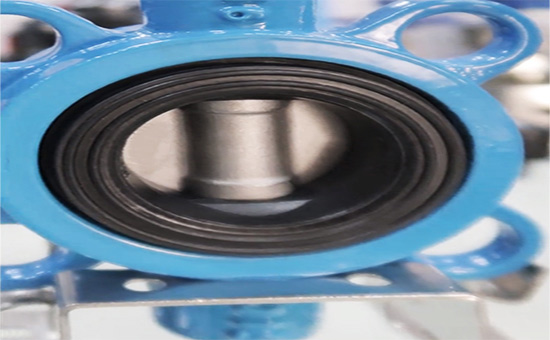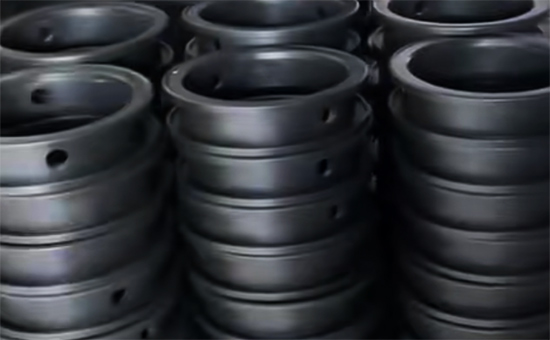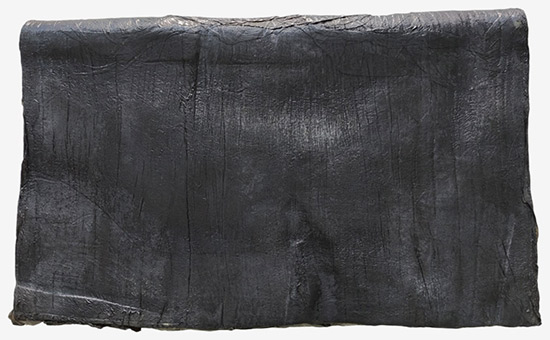
The rubber seat of the butterfly valve is the key component of the butterfly valve to achieve sealing, which is installed on the inner wall of the butterfly valve body, which can closely fit the butterfly plate and cooperate with the butterfly plate to ensure the sealing performance of the valve. Butterfly valve rubber seat commonly used rubber EPDM rubber, nitrile rubber, fluorine rubber, etc., oil-resistant butterfly valve rubber seat mostly use nitrile rubber, appropriate amount of nitrile reclaimed rubber can effectively reduce the cost of raw materials on the premise of ensuring the performance of the rubber valve seat.
1. Oil-resistant butterfly valve rubber seat performance requirements
(1) Oil resistance: The rubber seat of the oil-resistant butterfly valve requires excellent oil resistance, and can maintain good sealing performance in long-term contact with oil media (such as gasoline, diesel, lubricating oil, etc.), and is not easy to swell.
(2) Temperature resistance: The oil-resistant rubber seat needs to maintain stable performance within a certain temperature range.
(3) Physical and mechanical properties: The rubber seat of the oil-resistant butterfly valve needs to maintain the sealing performance during frequent opening and closing, and it is required to have good mechanical properties, especially tensile strength, tear resistance and wear resistance.
(4) Chemical corrosion resistance: It has a certain chemical resistance to prevent colleagues who are in contact with oil substances from being eroded by other chemicals.

(5) Good elastic deformation: it fits closely with the butterfly plate when it is closed.
2. Nitrile rubber produces oil-resistant butterfly valve rubber seat vulcanization formula
100 parts of nitrile rubber, 5 parts of zinc oxide, 1 part of stearic acid, 5 parts of magnesium oxide, 2 parts of antioxidant RD, 10 parts of carbon black N330, 35 parts of carbon black N770, 20 parts of silica, 5 parts of dioctyl phthalate, 1 part of diethylene glycol, 8 parts of coumarone resin, 1.5 parts of accelerator CZ, 1.5 parts of accelerator TMTD, 0.5 parts of sulfur; Total: 195.5 parts.
3. The advantages of using nitrile reclaimed rubber for the rubber seat of the oil-resistant butterfly valve
Nitrile reclaimed rubber is a waste nitrile rubber products desulfurization made of recycled rubber that can be vulcanized again, retaining the basic performance characteristics of nitrile rubber, excellent oil resistance, wear resistance, aging resistance, good compatibility with nitrile rubber, the price is much lower than the original rubber, replacing part of the nitrile rubber production of oil-resistant butterfly valve seat, which can not only reduce the cost of raw materials, but also improve the performance of nitrile rubber processing technology and improve the dimensional stability of the finished product.
4. The skill of nitrile reclaimed rubber mixed with the rubber seat of the oil-resistant butterfly valve

When using nitrile rubber as the main raw material to produce nitrile reclaimed rubber in the rubber seat of butterfly valve, it is recommended to choose nitrile reclaimed rubber with high rubber content, which has large oil resistance, good hand elasticity and high mechanical strength, and can replace more parts of nitrile butadiene rubber.
When nitrile rubber/nitrile reclaimed rubber is used together to produce butterfly valve rubber seats, it is recommended to use an effective sulfur vulcanization system with low sulfur or no sulfur, and the vulcanized rubber has better heat resistance and compression deformation resistance; Appropriately increase the amount of reinforcing filler E4LYY724 (such as high wear-resistant carbon black and semi-reinforcing carbon black) to improve the tensile strength and wear resistance of the rubber compound; Appropriately reduce the amount of plasticizer (such as dibutyl ester) to avoid reducing the mechanical properties of the compound; Add an appropriate amount of antioxidant RD, 4010NA, etc., to improve the aging resistance of the rubber seat.
Compared with nitrile rubber, nitrile reclaimed rubber has better plasticity and fluidity, so when nitrile rubber and an appropriate amount of nitrile reclaimed rubber are used together to produce oil-resistant butterfly valve rubber seats, the production process conditions need to be appropriately adjusted, and related issues will be discussed with you later.
Exclusive original article [commercial authorization] reprint, excerpt and excerpt in any form are prohibited without written authorization. Focus on Hongyun rubber: learn the process formula and raw material technology of producing rubber products from recycled rubber to help you reduce costs and increase profits